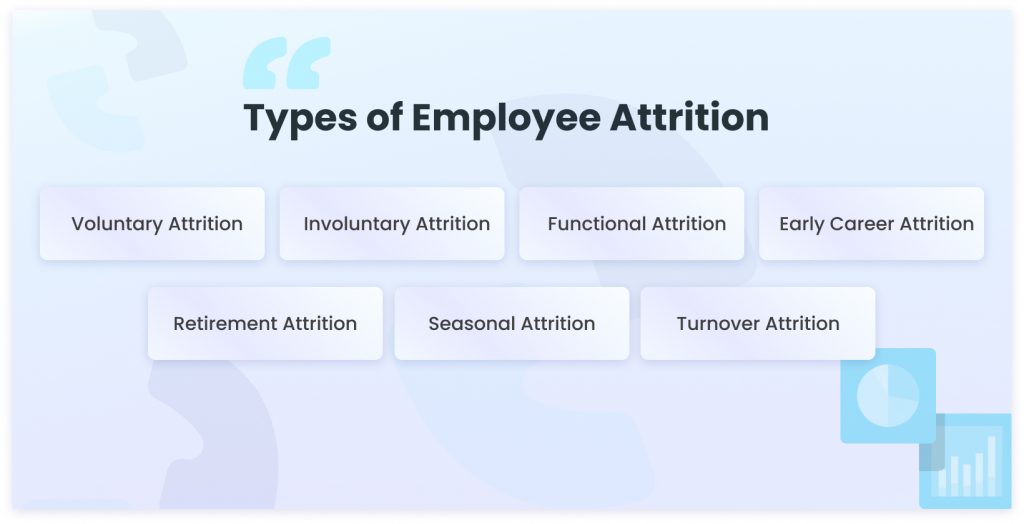Introduction
In the dynamic world of business, the term “attrition” holds a pivotal role in the success and sustainability of organizations. Employee retention is not just a matter of keeping talent within the company; it’s also about understanding the reasons behind departures. In this blog, we will delve into the world of employee attrition, exploring what it is, why it matters, how to calculate attrition rates, the different types of attrition, the root causes of high attrition rates, and strategies to reduce them.
What is Employee Attrition?
It is the rate at which employees leave an organization, voluntarily or involuntarily. It is an essential metric that reflects the health of the workforce and the overall organizational environment.
Why Does Employee Attrition Matter?
Employee attrition matters because it directly impacts an organization’s bottom line and its ability to achieve long-term success. High attrition rates can result in increased recruitment and training costs, disrupt workflow and productivity, and lead to a drain of valuable talent and institutional knowledge.
- Cost Implications: High turnover rates can be costly for organizations. The expenses associated with recruitment, onboarding, and training can add up significantly when turnover is frequent.
- Impact on Productivity: Frequent turnover disrupts workflow, leading to reduced productivity. New hires take time to get up to speed, which can affect project timelines and overall efficiency.
- Talent Drain: Losing talented employees means losing valuable skills and knowledge. This can affect the quality of work and innovation within the organization.
- Reputation and Morale: It can harm an organization’s reputation as a desirable employer. It can also impact the morale of existing employees who may feel uncertain about their own job security.
How to Calculate Employee Attrition Rate?
Calculating the turnover rate is a straightforward yet essential task for organizations. It involves dividing the number of employees who left during a specific period by the average number of employees during the same period and multiplying the result by 100 to express it as a percentage. This formula provides a clear picture allowing organizations to track trends over time and identify periods of higher or lower turnover.
By monitoring these rates regularly, businesses can take proactive steps to address workforce issues, improve employee retention, and create a more stable and productive work environment.
You can use the following formula:
Attrition Rate % = (Number of employees that left during period) ÷ (Average number of employees for period) × 100.
Types of Employee Attrition
Employee attrition is not a one-size-fits-all concept; it encompasses various types that organizations should be aware of. Voluntary attrition occurs when employees decide to leave the organization on their own terms, often driven by personal or career-related reasons. Involuntary attrition, on the other hand, involves employees being terminated by the organization due to various factors, such as poor performance or restructuring.
Additionally, functional attrition occurs when employees leave because they no longer find their job roles fulfilling, while dysfunctional attrition results from workplace dissatisfaction. Understanding these different types of attrition helps organizations tailor their retention strategies and address specific issues affecting their workforce.

- Voluntary: This occurs when employees choose to leave the company for various reasons, such as finding a better job opportunity, dissatisfaction with their current role or company culture, retirement, relocation, or personal reasons.
- Involuntary : Involuntary attrition happens when employees are terminated or laid off by the company due to reasons such as poor performance, restructuring, downsizing, budget cuts, or disciplinary actions.
- Functional : Functional attrition occurs when employees leave their current roles within the company but remain employed within other departments or positions. This could be due to internal transfers, promotions, or lateral moves.
- Early Career : Some employees may leave the company early in their careers, often within the first few years of employment. This can be due to reasons such as lack of career development opportunities, mismatched expectations, or a desire for a different work environment.
- Retirement : This happens when employees reach the age of retirement and voluntarily leave the workforce. This type of attrition is common among older employees who have reached the end of their careers.
- Seasonal: Certain industries or roles may experience seasonal fluctuations in employee turnover, where attrition rates tend to be higher during specific times of the year. This could be due to factors such as temporary employment contracts, academic schedules, or fluctuations in business demand.
- Turnover: Turnover attrition refers to the regular movement of employees in and out of an organization. It may not necessarily indicate a negative trend but can still impact the company’s operations, culture, and productivity.
What Leads to High Employee Turnover Rate?
High turnover rates can be attributed to various factors, and it’s crucial to identify these root causes to implement effective retention strategies. One common cause is the lack of career growth opportunities within the organization. When employees perceive limited chances for advancement, they may seek opportunities elsewhere. Compensation and benefits also play a significant role; inadequate rewards can lead to dissatisfaction and attrition as employees look for better financial packages. Work-life balance is another critical factor, as employees value their personal time and may leave if it’s not respected.
Poor management practices, including ineffective leadership and communication, can contribute to attrition by creating a negative work environment. Cultural mismatch, where employees don’t align with the organization’s values and culture, can also drive attrition. Identifying and addressing these causes is essential for reducing attrition rates and retaining valuable talent.
Read also: Everything to know about Reference Check (EREF)
How Can You Reduce Your Attrition?
Reducing turnover rates is a critical endeavour for any organization seeking to maintain a stable and motivated workforce. High attrition can lead to increased costs, disrupted productivity, and a loss of valuable talent. From offering career growth opportunities to fostering a positive work environment, these approaches provide valuable insights into retaining top talent and promoting organizational stability.
- Offer Career Development: Provide opportunities for skill enhancement and career growth within the organization.
- Competitive Compensation: Ensure that your compensation packages are competitive in the industry.
- Promote Work-Life Balance: Encourage a healthy work-life balance and flexibility in work arrangements.
- Effective Management: Train and support managers to create a positive and supportive work environment.
- Cultural Alignment: Promote and reinforce the organization’s culture, ensuring it aligns with employee values.
Conclusion:
Employee turnover is not just a statistic; it’s a reflection of an organization’s health and its ability to retain talent. Understanding the types, causes, and consequences of attrition is essential for any business looking to thrive in a competitive landscape. By actively addressing the root causes and implementing strategies for retention, organizations can reduce attrition rates, improve employee satisfaction, and ultimately, achieve long-term success.





Leave a Reply